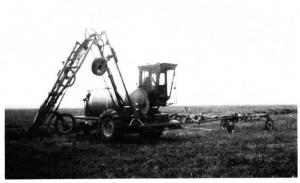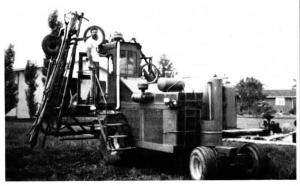1991 - Volume #15, Issue #3, Page #08
[ Sample Stories From This Issue | List of All Stories In This Issue | Print this story
| Read this issue]
Uni-Harvester Crop Sprayer
 |
 |
"We wanted a crop sprayer that didn't cost much and could cover a lot of ground fast," says Eric. "We paid $1,000 for the Uni-Harvester and spent about $1,000 to build the boom. Our total cost was about $3,000. We use it mostly for postemergence application of herbicides. It works great.,,
The Schmigdalls removed the shelling unit and installed a 900-gal. aluminum spray tank in its place. They used 3 by 3 and 11/2 by 3-in. steel tubing to construct the boom which is built in seven sections that follow the ground contour independently. The boom is folded by the hydraulic system that was used to raise and lower the header. Nozzles are spaced 30 in. apart and mounted on a pipe running the length of the boom and 1 ft. under it. The pipe is fastened to the boom framework by a series of rods equipped with set screws. By loosening the set screws, the Schmigdalls can change the height and angle of the nozzles on each section.
The boom's center section fastens directly to the Uni-Harvester frame. The two sections on either side of it are sup-ported by 14-in. car tires and the end sections are carried by motorcycle tires at the end of each section. A shear bolt allows the end sections to swing back if they hit an obstruction. "The boom folds up hydraulically like a planter marker," says Eric. "To spray along fencelines we fold up one side of the boom and drive beside the fence. We mounted extra nozzles onboth ends of the boom's middle section so we can double the rate of herbicide along field borders."
Foam marker nozzles are mounted at both ends of the boom. Air for the foam markers is provided by an air compressor removed from a semi truck. The air compressor and the cab's air conditioner are powered by the drive pulleys that powered the shelling unit. Old propane bottles serve as air tanks and a water softener tank is used as the foam mixing tank. Air hose quick couplers at the front and rear of the sprayer can be used to pump up tires or blow out plugged nozzles.
The air conditioned cab is equipped with a bank of electric toggle switches, each controlling a separate boom section, the left and right foam markers, lights, and air conditioner. A master switch can be used to shut off the entire boom at once. Field lights cover the boom and the spray tank for night-time use.
A 12-gal. tank behind the cab holds wash water to rinse hands and clean tools. Plumbing runs from this tank to the front of the engine radiator and exhaust manifold so water is always warm.
For more information, contact: FARM SHOW Followup, Eric Schmigdall, Route 1, Mackinaw, Ill. 61755 (ph 309 359-8016).

Click here to download page story appeared in.

Click here to read entire issue
To read the rest of this story, download this issue below or click here to register with your account number.




